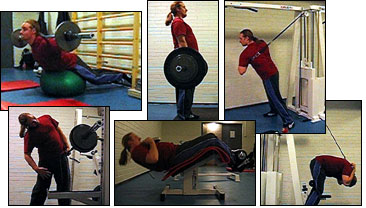Archives for rehab
June 4, 2006
Horse liniment
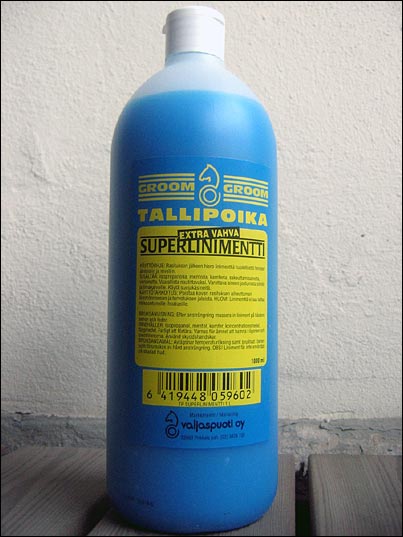
It all began when I found a thread over at Westsidebar discussing this very topic. The general party line was that normal cold liniments do not penetrate much deeper than the skin, but opinions diverged on whether the equestrian variety went much deeper to be effective. Apparently, some physical therapists recommend horse liniments precisely for this reasons, while others feel only ice delivers. Sanna also recalled that she had heard about the use of horse liniments during her massage therapy studies. Comparing the horse liniment with Ice Power and Cool Power (both common cold liniments sold here in Finland), it would appear that the active ingredients in cold liniments are some form of alcohol (isopropanol, ethanol or denatured alcohol), menthol, and possibly camphor (the horse liniment) or eucalyptus oil (Ice Power). The rest are standard cosmetic ingredients that gives the liniment its ice blue color or gel-like consistency. The horse liniment is much more runny than Ice Power, probably because it is easier to smear quickly over a large horse that way, and lacks glycerin or its equivalents.
Let me put it this way: the ingredient list (isopropanol, menthol, camphor, thickening agent and food colors) of the horse liniment I bought reveals no super potent ingredient not found in the standard cold liniments sold in pharmacies and sports departments, unless that would be camphor… If the horse liniment is more effective it is because it has higher concentrations of active ingredients than the human intended brands. The major reason, besides the possibility that it is indeed a tad more potent, to mess around with horse liniments would appear to be price. I paid 9 euros for a liter of horse liniment from the equestrian section of a local supermarket whereas the liter price of Ice Power is 50 euros if bought in the biggest container. Think about that for a second. Thomas Deebel pretty much summed it up when he was asked why EliteFTS only sell veterinary liniments:
The vet products are actually cheaper for you to purchase. The liniments I have to sell in my office are actually about the same, but cost 4X as much money.
There you have it. Sorry for dissolving the mystique surrounding the powerlifter as a mighty horse.
November 26, 2005
Hope
To say that training is going well may be a slight overstatement. Two years have passed since the notorious back injury, but the pain is still with me. I have gone through two major cycles of lumbago characterized by a major cramp that pulls the hip out of alignment followed by rehab and brief glimmers of hope. After being able to pull off a few decent squat workouts, I seem to be getting worse again. This time around a visit to the back clinic appears futile; I know the diagnosis, I know how to rehabilitate it… I also know it will come back. I don’t doubt their expertise, but am starting to question whether it is adequate for whackos like myself who load their spine with limit weights and call it a hobby. I might never be able to reach my goal of putting up some decent numbers on the squat and deadlift, but I am not ready to give up any time soon. Only another whacko will understand why.
As I was pondering where I could find a physical therapist with some knowledge of powerlifting, it finally dawned on me that Elite Fitness Systems has a question and answer section dedicated to rehabilitation of powerlifting injuries. They have an impressive staff manning it too. It took me a while to formulate a good synthesis of my problem within the narrow constraints of the allowed number of characters, but it was more than worth it. Within a day or so, I had received an encouraging answer from Michael Hope, a physical therapist currently practicing at the Summit Physical Therapy in Syracuse, New York. I have taken the liberty of inserting relevant hyperlinks.
Kris: Rehab Q: Two years ago (Dec 2003) I sustained a good morning injury (felt like something “rolled down” the middle of the low back, slight bruising, impossible to sit for the next few days). I continued benching while treating the injury with RICE, painkillers and very light accessory work. 3 months later, a chiro adjusted me after sub-max squats caused the left side of my back to stiffen up. I also treated myself for gluteal trigger points.
In May 2004, I got my first full-blown lumbago (severely drooping right shoulder) after light squatting. Got muscle relaxants and painkillers. A back specialist put me on the McKenzie extension protocol, neural mobilization and a core training program (swiss balls, balance boards). He told me the right side of my lower back was not fully contracting. After 3 months of religious rehab work, I got another bout of lumbago after light box squats (ok’d by therapist); continued the same treatment.
In March 2005, 15 months after the initial injury, I was finally doing regular ME squat/dead work. Everything was fine until I got another case of lumbago in August 2005 after decline benching. The back specialist could find nothing structurally or neurologically wrong with my back. Apparently, the lumbago is triggered by compression of the spine which causes the nucleus to spill over and irritate the nerve roots. Am now focusing on strengthening my midsection (reverse hypers, side bends, abs…), while carefully regulating heavier SQ/DL work. Sleeping and sitting long hours can also trigger a mild case of lumbago (always tilted to the right). The recurrent pain is not too bad, but zero SQ/DL progress over the last two years is no fun. Giving up is not an option.
I would HIGHLY appreciate any suggestions. Am also curious whether this is a common injury scenario in powerlifting. I lift raw but could reluctantly consider equipment if that could help keep me under the bar. I live in Europe and am 30 years old. Thanks for your time!
Michael Hope: If you get a tilt to the right you present as a lateral shift. You need to perform lateral procedures before you do extension procedures per McKenzie
The sitting for prolonged periods of time may be a sustained flexion load. Produces posterior and lateral disc migration.
Did you notice it always takes three months for you to get better. This is how long it takes people to get better if they do nothing at all.
If you’re not getting worse with activity( lifting) but are getting worse with inactivity(sleep and sitting) then try to fix these postures.
You have a poor internal mechanism( weak annulus) With bad postures this will get loaded and weakened and more likely to injury with minor tasks.
Ironically the spine is quite resistent to herniation with compression. Brinkmen(research) cut a disc trying to create a herniation with compression loads… it could not happen however as soon as flexion was introduced the disc herniated.
You must remember that reverse hypers are a crushing compression force with a flexion component.
Can you currently squat?
Can you currently deadlift from a high pin position?Why do you think you are weak in “core”?
The combination of heavy compression and heavy core training may be too much…You may try to re-estblish squatting with minimal assistance training(core training)
If squatting is out of the question, then try single leg exercises. I have found these to be tolerated by individuals who can not tolerate heavy squatting.
Michael Hope
I received another cosmically significant answer a few days later to my follow-up questions. For increased readability, I have matched question to answer on this one.
Kris: Dr. Hope, thanks for the very insightful answer (11/21/2005)! Too much compression in the gym appears to be the main stressor, several days of sitting/sleeping extensively can be nearly as bad. I did extensions with feet out to the left while tilted to the right, then switched to regular McKenzie, would this qualify as a proper lateral procedure? Squatting in the 60-70% range usually works, if not stiff I can max out without causing lumbago. Cannot go very heavy on high pin pulls unless totally pain-free. I hear you about posture, will seek advice, thanks.
Michael Hope: Glad too see you are resolving.
Ironically I just read an e mail from Vinnie 11/25/05 he was lifting and got injured what he describes is a lateral shift like yourself. I recently treated a SWAT officer with a lateral shift. Shifts are not common problems.
Some of his guidelines may help you in the future. I corrected his shift on day one. He did shift corrections for one day and was placed in a CASH orthosis. This brace does not allow him to flex. On day two his shift was corrected and he began extension procedures. He was to perform one side glide every hour to make sure he had no obstruction to side gliding. Once he was pain free for five days to test his stability I had him perform standing flexion 50x and sit slouched for twenty minutes. This produced no pain and created no obstructions to movement. His condition was resolved.
If down the road he developes low back pain he will perform sidegliding and extension to see if his motion is obstructed If it is he resumes his exercises 10x every one to two hours.
Before I answer your questions remember I try to to give what I believe are safe exercises based on science. I have been asked about RDL, Good mornings and GH raises. They are not rehabilitation exercises. I had a conversation about this approach with Stuart McGill a few years ago and he is in agreement about this point. He has testified in court against therpist who decided to use high compression strong muscle activation exercises for spinal rehabilitation. He had science on his side they had it was a good exercise on theirs.
Kris: Sorry for the long list, but this is the first time I am getting any help from someone who understands PLing and I am eager to work out a plan of attack. Any advice would be much appreciated. Thanks for helping me out!
Should I consider the Ironmind Super Squats Hip belt as a way of rebuilding some strength in the legs while lowering compression?
Michael Hope: Yes this would be a good place to start
would use a wide stance.Kris: Can spinal compression build over time, i.e. the spine get progressively more compressed week after week? Am thinking in terms of doing a couple of weeks of reasonable loading (using first occurance of minor lateral shift as an indicator) followed by 1-2 deload/decompression weeks (perhaps only hip belt work here).
Michael Hope: spinal compression does not build up like you stated. It is increased with positions then reduced with others. This is known as creep and hysteresis. Using periods with safer exercises ( delaoding is probable a good thing) every other group gets some time off why not the spinal muscles.
Kris: Should I ditch the reverse hypers altogether?
Michael Hope: The revers hyper is a very good exercise to improve posterior chain strength and is necessary to have a heavy squat. You may try limiting how far the feet come under you. I would limit the arc to the point where you can keep the lordosis. There is no value of rounding your spine. Trying to generate a major contraction of the spinal musculature and hips from the flexed posture is not a good idea.
Kris: Does a stronger core equal less compression at all (my reason for focusing more on abs and the posterior chain)?
Michael Hope: Core training and improved compression is necessary to have a stable base from which to move from. The delimma that arises is how much stability is necessary. Power lifters are unique in that they are alwyas trying to lift greater loads which require greater support.
Athletes are not the same. In some cases less compression exercises will keep them playing. Training is used to bring up weaknesses, work on high risk areas of injury and selecting exercises that will improve their strength while minimizing injury during training.
Kris: What would be good ways to relieve compression, how frequently should they be used?
Michael Hope: Most spinal compression is produced with sustained flexion( poor posture) and repeated bending. This again goes back to creep and hystersis. Good sitting posture more than bad is a good place to start. Implement extension or overhead reaching during the day to offset flexion forces.
Kris: Would you say my weak annulus will stop me from becoming competetive in the SQ/DL or is this something that might be resolved long-term with proper rehab and posture correction?
Michael Hope: As the nuclues dries out and becomes fibrous,it is less able to exert fluid pressure, Thus the nucleus is less able to exert radial pressure on the annulus fibrosus. Consequenly, the annulus is subject to greater stresses Nucleus breakdwon is a normal painless process. There is science to suppport that not all changes are age realted, some are active metabolic responses to change in the internal stresses of the annulus( changes in Type 1&2 collagen.
If you continue to have frequent episodes of lateral shifting then you are continually weakening the structure so the disc material will take the path of least resistance.
Most athletes will have back pain like yours and think it is a muscle… So they stretch it out usually more flexion and greater chance of injury. They sit slouched on a bench between sets more chance of injury( plus hysteresis). Those pains in my opinion are early warning signs and it aint muscle sending those messages. It is the disc. 50% of the time it is the disc that is causing pain.
Kris: Would using equipment help at all in lessening compression? Currently raw, not even using a belt.
Michael Hope: The belt is not favoured by some exercise specialist because they read the research that belts dont help prevent low back pain and may lessen the muscles ability to supprot the spine. This assumption can not be made with heavy lifting. This information came from back pain suffers. Not guys squatting 700 lbs. I would say with heavy squatting use a belt it will act as a counterforce to the abdominal pushing out.
Kris: Would you recommend any specific supplementary activities (swimming, sled dragging…) for keeping my spine active without undue strain?
Michael Hope: James Smith and I have had this conversation we are both in agreement that you should pick something that has diffrent movement patterns and loading patterns.
Because of my back ground i like heavy bag training work both punching and kicking. Remember No one said you had to be good at something to like it. Your body is forced to move out of the sagital plane. this is the moving pattern that all squatting and deadlift are done in as well as benching.
Remember if you can’t perform low level compresssion exercises safely most likely the big ones will be worse.
Exercise selection is misunderstood when treating low back pain. Good exercises for strengthening need to be put into the program when appropriate. No one would tell a torn ACL afer four weeks to begin depth drop jumps on to a single leg if they have never done loaded lunges with out buckling or pain.
One more consideration science is realizing that resolved low back pain athletes still have firing latencies. This may mean they are still suspect when it comes to protective movements.
what a long answer,
Michael Hope
Looks like I have been going about it the wrong way. Whenever I have had encountered renewed back pain, I have strived to counter it by lessening the amount of heavy loading (squats, deadlifts…) while increasing the amount of core work (stability balls, abdominal exercises…). This makes perfect sense if high levels of spinal compression is taken as the sole culprit. Turns out the equation was missing one vital piece, flexion (forward bending). The research Michael cites is in agreement with that of Mr. Spine, Stuart McGill:
A couple of years ago we sought the most potent mechanism leading to disc herniation. Given that it was critical to create a homogeneous cohort of specimens, we chose a pig spine model, controlling diet, physical activity, genetic makeup, disc degeneration, and so forth. We found that repeated flexion motion under simultaneous compressive loading was the easiest way to ensure herniation. In fact, it turned out that the number of cycles of flexion motion were more important than the actual magnitude of compressive load. [..] The herniated disc appears to result from cumulative trauma: even though we have crushed well over 400 vertebral motion segments, we have only once or twice observed a herniation without concomitant flexion cycles. Note that we are including both frank herniation and visible disc bulges under this category of injury mechanism. [..] [H]erniation of the disc seems almost impossible without full flexion. This has implications for exercise prescription particularly for flexion stretching and sit-ups or for activities such as prolonged sitting, all of which are characterized by a flexed spine. Some resistance exercise machines that take the spine to full flexion repeatedly must be reconsidered for those interested in sparing the posterior annulus portions of their discs.
McGill, Stuart (2002): Low Back Disorders, Human Kinetics: pp. 55-56. My emphasis.
Spinal compression caused by bending is the problem, not compression per se. Hence Michael Hope suggests I do the precise opposite to what I’ve done so far: minimize bending exercises (abs, full range reverse hypers and so on) and focus on re-establishing squatting, an activity where the load is transfered to a fairly neutral spine. At the risk of restating the obvious, heavy squatting is not the problem, all those “light” core exercises are. If this is indeed so, it is easy to see why it would take me a full three months to heal up. Simply put, many of the exercises I did in the name of rehabilitation (reverse hypers, standing cable crunch, side bends…) were themselves major sources of compression caused by flexion.
My new plan of attack:
- Focus on squatting, drop or minimize all exercises with a flexion component for now. Use a belt on all heavy squats.
- Start to do reverse hypers with a shorter range of motion to keep the back from rounding (no more swinging!).
- Purchase a squat hip belt.
- Subject the spine to a different loading pattern through heavy bag work done before every workout.
- Continue to relieve compression by paying attention to sitting posture and time, and by doing frequent overhead reaching.
Whether this is a first step to a viable solution or just another brief glimmer of hope remains to be seen. Mood: optimistic. Thanks to Michael Hope for taking the time to answer and to Elite Fitness Systems for providing this service!
August 31, 2005
Good traditions, bad traditions
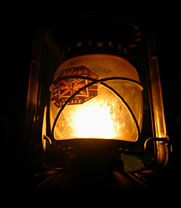 A veritable sea of light by the sea as lanterns, torches and bonfires light up the last dark weekend of August in the archipelago… the End of Summer festival is one great tradition indeed. Where there is great light, there must also be great darkness…evil traditions are arising out of its shadows. It doesn’t take Yoda to understand that I was out there looking to improve my 105 kg/232 lbs decline PR. I didn’t get it, instead I got what I got last year this very weekend… heavy duty back pain and a strong case of lumbago.
A veritable sea of light by the sea as lanterns, torches and bonfires light up the last dark weekend of August in the archipelago… the End of Summer festival is one great tradition indeed. Where there is great light, there must also be great darkness…evil traditions are arising out of its shadows. It doesn’t take Yoda to understand that I was out there looking to improve my 105 kg/232 lbs decline PR. I didn’t get it, instead I got what I got last year this very weekend… heavy duty back pain and a strong case of lumbago.
Not perhaps quite as bad as last year, but I had to forego all plans to clean up the debris in the gym following this year’s extensive renovation. As soon as I got back to Helsinki, I did the usual round. Actually, I didn’t even need to set foot in the occupational health clinic as a phone call was enough to get me the usual muscle relaxants and strong pain killers. At the back clinic, the doctor at first tried to ease up the cramp with the same means as a month ago, but he quickly abandoned the neural mobilization as even the starting position was severely painful. Instead, he jammed two pins into my low back to electrically force the cramping muscles to repeatedly contract in an effort to tire them. It is an experience in itself to feel the small muscles around the spine contract, I doubt they can be caused to fire in isolation without artificial means. After some fifteen or twenty minutes of contract-relax-contract-relax-contract-relax, I knew I would be sore in some funky places… The doctor told me I could expect the cramp to ease up over the next couple of days. He concluded that there was nothing structurally or neurologically wrong with my low back, something I should be thankful for. Knowing my scientific bent, he went on to sketch a picture of a vertebral disc from above explaining how the jelly-like center, the nucleus, is contained within a fibrous ring known as the annulus. Under normal circumstances, the disc returns to its original shape after absorbing pressure. But with age, the annulus is weakened and cracks can occur causing the acidic nucleus to spill out of its container thus coming into contact with the nerve roots. This in turn is what causes the lower back to cramp leading to the leaning tower of Pisa effect as the cramp causes the hip to shift to one side with a considerable drooping shoulder on the opposite side. This page over at a French back clinic explains this well with pictures, including the one below (the text is in English though).
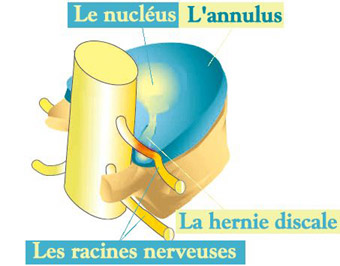
Almost into my second year of recurrent back trouble following the you-know-what, I received a clear diagnosis I can understand. This is so important I need to bold, hold on… What causes my back trouble is not a lingering back injury, but disc leakage due to abnormal levels of compression. Unfortunately, it appears that my “abnormal levels of compression” is abnormally low, say a 100 kg/221 lbs squat or 107.5 kg/238 lbs decline bench attempt. That said, it is not like this problem pops up out of the blue something. I have been able to sustain high levels of compression since the injury (for example, the Coan deadlift cycle in the spring), but for some reason a little is sometimes suddenly just too much. A stiff back, like I had before this workout, is a much more serious warning sign than I have ever understood. What this means to my powerlifting future, beyond the “stay away from the decline for now”, remains to be seen. Gargllleeeee.
Decline bench:
5 @ 40 kg/88 lbs
5 @ 50 kg/111 lbs
3 @ 60 kg/133 lbs
3 @ 70 kg/155 lbs
1 @ 80 kg/177 lbs
1 @ 90 kg/199 lbs
1 @ 100 kg/221 lbs
0 @ 107.5 kg/238 lbs
Behind-the-neck press:
8 @ 30 kg/66 lbs
5 @ 40 kg/88 lbs
3 @ 50 kg/111 lbs
3 @ 60 kg/133 lbs
0 @ 70 kg/155 lbs
0 @ 65 kg/144 lbs
July 19, 2005
Rewarding visit to the back clinic
No, don’t worry. Didn’t kill my back again. Just figured that it was high time for a diagnostic visit to the back clinic to assess the condition of my back and to have my upper back adjusted. Was I ever happy I went!
The therapist, incidentally the head honcho of the establishment, had me do some of the standard bending and arm lifting before drawing my attention to the ever so slightly drooping right shoulder. Another protective response caused by the movement of the nerves being restrained. After a massage of the back, he proceeded to increase the mobility of the upper back. “The sound will resonate in your skull” he told me before twisting my neck, and was he ever right. Then he had me sit down with extended feet and told me to bend over. He leaned on top of me and pushed my head down in a few controlled jerky movements. Felt like torture, but after every few reps I could bend down further. He had me stand up and I could suddenly easily touch the floor with my arms. “What I just did stretched the neural tissue about 9 centimeters”. Wow.
This was followed by another neural mobilization exercise that felt like it would stretch my quads apart. “The interesting thing here is that the sensation has nothing to do with the muscle itself, but only the nerve.. the muscles themselves are nowhere near being stretched to an extreme”, he said in between jerks. He said that I can continue to train as normal, but should start to do 3 minutes of neural mobilization every day to ensure that I keep healthy. He further explained that this will be beneficial for my raw strength as well since restrained neural mobility will cause the brain to be quite conservative about how much force it allows the muscles to produce. When I asked whether I should come back ever so often for a check-up, he responded with an analogy: “you don’t drink cough medicine to prevent coughs, come back if you feel something’s up”. Three minutes of self-administered torture a day it is.
Today, one day after the visit, I feel swell and mobile. A good state to be in as we are now off to the summer cottage again. Will be backblogging my adventures in three weeks, since I rather enjoy the freedom from the lure of the computer. Power rack, here I come! ![]()
December 27, 2004
Walkout pikes
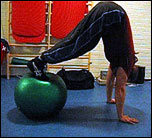 I must have been a good boy this year cause Santa gave me a balance board, tiger balm liniment and Jeck’s stonelifting book off my Amazon.com wishlist in addition to various useful non-strength items. The balance board was especially welcome since I have started to skimp on the rehab stuff after leaving Toffe’s Gym and my homemade board behind. This board is a tad less shaky although being classified as “hard”, but definitively enough for my needs.
I must have been a good boy this year cause Santa gave me a balance board, tiger balm liniment and Jeck’s stonelifting book off my Amazon.com wishlist in addition to various useful non-strength items. The balance board was especially welcome since I have started to skimp on the rehab stuff after leaving Toffe’s Gym and my homemade board behind. This board is a tad less shaky although being classified as “hard”, but definitively enough for my needs.
ME SQ/DL was supposed to be on today’s agenda, but since the venerable lower back has been suffering from some residue stiffness due to the sudden reintroduction of box squats, I dedicated this workout to rehab. First tried a new stability ball exercise known as walkout pikes, essentially a normal walkout followed by folding the body at the midsection (picture) - a great one for the lower abs if you ask me. Then followed up with a rehab circuit with the normal 5 minutes between iterations. Almost lost my lunch after the third one, possibly because I only had it 60 minutes earlier. Lesson learned: the only friendly hamburgers are homemade.
Walkout pike: 10,7,7 @ bodyweight
3 circuits of:
Hanging leg raise (feet to bar): 7,6,5
Balance board lunge: 8,8,8
Hyperextension on stability ball: 15,15,15 @ 10 kg/22 lbs
Lower cable twist: 10, 10, 10 @ 30 kg/66 lbs
Stability ball crunch: 30,30 (skipped last due to aforementioned lunch problems)
Total training time: 40 min
December 6, 2004
Making the rounds
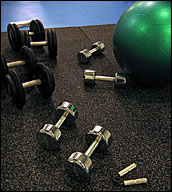 Finnish Independence Day. No work. To give the central nervous system and the shoulders further respite, I went for an upper body circuit routine with fairly light weights, one major movement per muscle group and a focus on stability ball exercises. I moved quickly between exercises only stopping to jot down the results until one iteration was completed, then took five minutes of rest before going at it again. I was huffing and puffing and kept reminding myself of the need to raise GPP, cause I ain’t got any. 23 minutes later it looked like the 5th Annual Dumbell Congregation had just convened in front of the stability ball. On our way home we ended up sitting in a traffic jam as the police had just blocked off one of the main arteries to make room for the dignitaries on their way to the President’s Independence Day Reception. System flooded with healing blood, can wait.
Finnish Independence Day. No work. To give the central nervous system and the shoulders further respite, I went for an upper body circuit routine with fairly light weights, one major movement per muscle group and a focus on stability ball exercises. I moved quickly between exercises only stopping to jot down the results until one iteration was completed, then took five minutes of rest before going at it again. I was huffing and puffing and kept reminding myself of the need to raise GPP, cause I ain’t got any. 23 minutes later it looked like the 5th Annual Dumbell Congregation had just convened in front of the stability ball. On our way home we ended up sitting in a traffic jam as the police had just blocked off one of the main arteries to make room for the dignitaries on their way to the President’s Independence Day Reception. System flooded with healing blood, can wait.
3 circuits of:
Stability ball dumbell bench: 12 @ 21 kg/46 lbs
Wide-grip pulldown, facing away from machine: 10 @ 60 kg/133 lbs
Side raise kneeling on stability ball: 8 @ 10 kg/22 lbs
Dumbell power clean sitting on stability ball: 12 @ 8 kg/18 lbs
Pressdown (lat pulley): 15 @ 25 kg/55 lbs
Dumbell curl seated on stability ball: 6 @ 16 kg/35 lbs
Captains of Crush: 10 @ Trainer
Lap times: 1st 4:40, 2nd 4:10, 3rd 4:10
Rest between circuits: 5 minutes sharp
Total training time: 23 min
November 17, 2004
HardCORE rehabbing
Well… the weights were still pathetic, but heavier than last week. Pounded the midsection hard with weighted everything, including hyperextensions off the swiss ball and heavy barbell side bends. Bravely continued to up the weight on the deadlift. Perhaps, perhaps… wet dreams of ME SQ/DL and so on.
Today’s music was Finnish death metal band Norther’s Mirror of Darkness and today’s lesson learned that if you bounce a barbell off pads it is liable to come right back up and hit you in the forehead.
Barbell hyperextension on swiss ball:
6 @ 20 kg/44 lbs
8 @ 30 kg/66 lbs
8 @ 35 kg/77 lbs
7 @ 45 kg/99 lbs
Deadlift (slow):
6 @ 60 kg/133 lbs
6 @ 70 kg/155 lbs
6 @ 80 kg/177 lbs
6 @ 90 kg/199 lbs
Upper body cable turn: 3x25 @ 50 kg/111 lbs
Barbell side bend:
8 @ 20 kg/44 lbs
6 @ 30 kg/66 lbs
5 @ 40 kg/88 lbs
5 @ 50 kg/111 lbs
Incline board sit-up (full reps):
3 @ 10 kg/22 lbs
7,4 @ bodyweight
Standing cable crunch:
6 @ 40 kg/88 lbs
5,3 @ 45 kg/99 lbs
Total training time: 98 min (and a lot of this fits into a five minute video…)
October 13, 2004
New beginnings
Nice to again be able to kneel on a stability ball without calf pain. Regular rehab begins again, hopefully without another relapse. Even did some light one-handed deadlifts.
Trunk twist with stick kneeling on stability ball: 4x30 seconds
Walk outs with arm and leg lift: 20,18
Arm and leg extension kneeling on stability ball: 2x12
Hyperextension: 15 @ bodyweight, 15 @ 10 kg/22 lbs
One-handed Deadlift: 6 @ 18 kg/40 lbs, 8 @ 24 kg/53 lbs
Upper body cable turn: 2x30 @ 30 kg/66 lbs
Spread-eagle sit-up:
10 @ bodyweight
10,7 @ 5 kg/11 lbs
Ab hold: 2 sets
Total training time: 45 min
September 8, 2004
A workout for gentlemen
First workout after my recent bout of lumbago. It was a moderate cocktail of easy rehab moves framed against a very contemplative background. I could tell my back was not quite over it yet, but overall things look A LOT brighter than in Lumbago Episode I. With the hams and calves feeling like they are still on the verge of disintegrating, I stopped my attempt at pushing some blood in there after a set on the Hamflexor standing one-legged curl with nearly no weight felt ridiculously heavy. Finished with some light stretching, but despite being warm all over I still could not convince my inner thighs to allow a full banana extension.
In between my sets of reverse hypers, I also bumped into the osteopath who mobilized my back in March. He asked me how my back had been. Deviously enough, he asked me because his trained eyes had spotted the problem as it entered the gym. Or perhaps he had just noted the limping left leg with the tired post-party eyes he off his lofty treadmill confessed having.
Muscle activation, lat pulley: 2x25 reps each of facing, right and left @ 20 kg/44 lbs
Hamflexor standing one-legged leg curl: 10 @ 30 lbs/14 kg [rolling eyes]
Upper body cable turn: 2x30 @ 25 kg/55 lbs
Standing cable crunch, lat pulley: 20 @ 20 kg/44 lbs, 15 @ 30 kg/66 lbs
Reverse-hyper, done off hyper bench: 3x30
Walkouts: 10
Total training time: 25 minutes or so
September 6, 2004
Bipedal
Left the lair behind and survived a day at work. Apparently all the theracaning and light stretching is bearing fruit. Yesterday Sanna gave me a thorough calf massage; turned out the whole calf is more or less a single pain zone. That seems to be the last hurdle before I can walk without a limp again… Think I will hit the gym on Wednesday. Stupendous.
